Two Brothers: A (Mostly) Oral History of DC vs. Marvel
A look at the greatest clash in Big Two history and how they became one, if only for a week
DC Comics vs. Marvel Comics. It’s a debate that has raged for decades now. Which is better? Whose characters are stronger? Faster? Cooler? As kids, these discussions were earth shattering in their importance. As adults, they can be even more so. And while the two sides and their characters met from time to time throughout the years, there was very little done to settle the debate. Until 1996, that is.
That’s when – for the first and only time – the two sides met for the ultimate tale of the tape. DC vs. Marvel, the event series to end all event series, ran for four issues from December 1995 to March 1996. It told the story of two massive cosmic beings – brothers who each represented a universe – and what happened when they finally became aware of each other.
Within its pages, many questions were answered. Could Batman beat Captain America one-on-one? Would Superman be able to outmuscle the Hulk? Which speedster is king: Quicksilver or The Flash? That’s just the tip of the iceberg, and when paired with Amalgam – an event within the event that created mash-ups of the most popular Marvel and DC characters like Dark Claw (Batman and Wolverine) and Super-Soldier (Superman and Captain America) – it was something many had been waiting for.
But how did it happen? Who was at the center of this unexpected and unlikely event? And why did DC and Marvel finally bury the hatchet and accomplish something never seen before and never seen since?
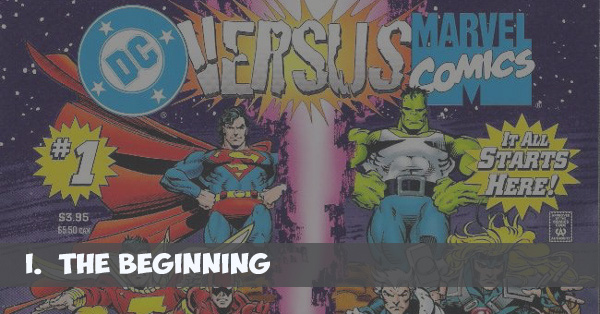
The story begins in the 1995, a turbulent year in comic history. The industry was struggling post speculator bubble crash and Marvel and DC were facing stiff challenges from Image and Valiant. DC Executive Vice President & Publisher Paul Levitz and Marvel President Terry Stewart were looking to stimulate sales and tasked DC Executive Editor Mike Carlin and Marvel Executive Editor Mark Gruenwald with finding a way to do that.
Carlin and Gruenwald were the architects of the DC vs. Marvel event, and the players who fought the hardest to bring it to life. A big reason for that was the friendship they shared.
Peter David (DC vs. Marvel co-writer): The thing is Mark and Mike worked together at Marvel Comics and they were deep friends.
Ron Marz (DC vs. Marvel co-writer): They were essential in making it happen in the manner in which it happened. I think you could hand this to most pairs of editors at Marvel and DC at the time and they would get the job done, but this was really a labor of love for those two guys.
Peter David: There’s was probably the most entertaining editorial office at Marvel Comics. I remember one time they closed their door for like 24 hours and no one was allowed in. The entire day we heard hammering and sawing and nails being pounded, and the next day when you walked into their office, they had built platforms for their desks so they were now three feet off the ground. It was freaking hilarious.
Tom Brevoort (Spider-Boy Editor): Mark really was – if you scratched down and got deep below the surface – he was a DC fan. He loved the DC characters as much if not more than the Marvel characters. It just so happened that he worked here. He worked at Marvel and gave his all to Marvel. So Mark having a chance to actually play with those characters and do things with those characters, I think it was something he would have pursued and pursued more doggedly than other people might have to make it happen.
Peter David: Mike and Mark were just terrific friends. To my mind, Marvel vs. DC was always kind of like Mark and Mike’s story. Two brothers in everything but blood whose heroes went against one another, and at the end, the two brothers decided it was good. It was basically Mark and Mike looking at Marvel and DC and saying, “yeah, your stuff is good too.”
Carlin and Gruenwald developed it in the beginning, but the project was built on the ideas of the two editors and the two writers brought onto the project before anyone else even knew about it: David and Marz.
Peter David: They wanted two writers to work on it, both of whom had ties to both companies. And they decided that Ron Marz would be one and I would be the other. And I said, “Sure, that sounds tremendously exciting.”
Ron Marz: It was completely a popcorn project and it was the sort of thing you’d do if you were 12 years old.
Peter David: We were going to be making history. We were going to be making a four-issue series in which Marvel fights DC. How would I not want to be a part of that? How would anyone not want to be a part of that?
Ron Marz: When I got a phone call about it from Mike Carlin, I was cautioned to not breathe a word to anybody, obviously including anybody at Marvel or DC. The vast majority of the staff at Marvel and DC didn’t even know it was happening. So the initial meeting we had wasn’t even on site at either place. It was at Mark Gruenwald’s apartment.
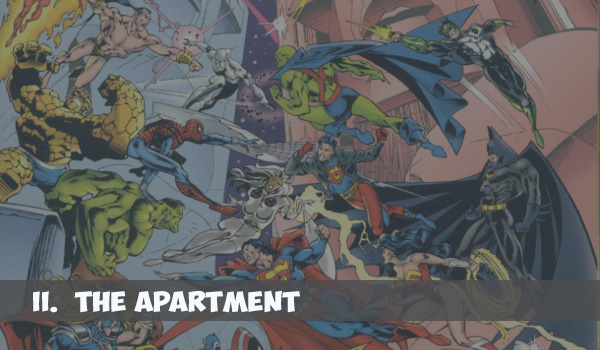
This meeting between Carlin, David, Gruenwald and Marz was where the entire event was developed and planned. It took place at Gruenwald’s apartment and a Mexican restaurant nearby.
Ron Marz: We initially sat down and sort of came up with the framework of the two universes. We even got into the basics of deciding that, yes, these were separate universes and we had to have some mechanism for those universes to come together, rather than pretending that everyone was in the same place and just hadn’t stumbled into each other previously.
Peter David: I think it’s possible that I came up with the fundamental concept of two cosmic beings going up against each other. The reason I’m thinking that was my idea was it was a gag I had already did in another novel called Photon. It was part of a Photon series in which I basically used the same fundamental concept. So it’s possible I was the one who came up with that.
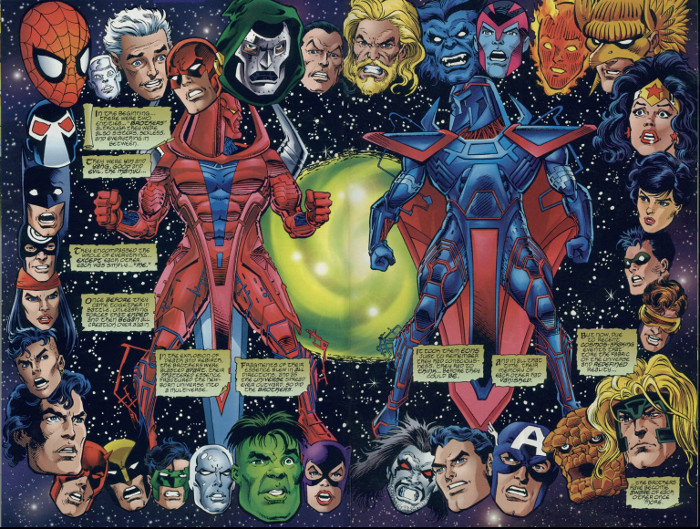
Ron Marz: That was the high concept and we kicked it around for an hour or two. Let’s face it, it’s not like we were building a great character drama, frankly. We were building a mechanism so fans could see the heroes fight each other.
Peter David: The bulk of what we were going to do was conceived at that point. We worked out the basic beats of the four issues.
Ron Marz: We spent a bit of time coming up with the mechanism and then probably spent more time on figuring out which heroes should be fighting each other. Which matchups made the most sense? Which ones we could use because the state of the respective universes…who was Spider-Man at that point? What costume did Thor have on? Did Superman need a haircut? A lot of them were obvious. Batman was obviously going to take on Captain America. Superman was going to take on the Hulk rather than Spider-Man because that would be a really short fight. We prepared lists of who should oppose who.
Peter David: The most heated debate was coming up with the way the heroes could defeat the other heroes. We didn’t want people all being knocked unconscious. And what we decided to do was come up with the way that someone wins in wrestling, which is that one hero had to pin the other for three seconds. Now I don’t care who is fighting who, pinning somebody for three seconds is doable.
Ron Marz: Honestly, sitting around Mark’s apartment, you could have mistaken us for a bunch of 10 year olds sitting in a tree house making up lists of who should fight who from the Marvel and DC universes. The one difference being we were actually going to be able do it.
Peter David: It was easily one of the most entertaining creative days of my entire career. Because it was the four of us, who were essentially all grown up fanboys actually being able to bring to life the fundamental concept of “well, what happens if Superman fights Spider-Man?” These are the kind of battles we’ve been wondering about and debating with our friends about for all of our years growing up. And it happened on that day. We were essentially indulging in wish fulfillment.
Ron Marz: While we were still at Mark’s apartment, Mark and Mike dropped what was the big bomb of the day, which was we were going to have a month in the middle of the four issue series that would smash the two universes together as one.
Tom Brevoort: Amalgam wasn’t the original name. Amalgam was the name that got settled on because they couldn’t get trademark clearance on the original name. The original name of both Amalgam and the Access character was going to be Rival. It was going to be Rival Comics.
Ron Marz: The Amalgam characters were mostly already in place. I never actually asked but my assumption always was that Mike and Mark just came up with them. I remember writing down the various combinations that were going to take place and which company was going to produce those books. And when they got to Doctor Strangefate, I just said, “well, I’m doing that one.” I don’t recall that I actually asked for it. I just said I was doing it. (laughs) And they were cool with that.
Some elements were left on the cutting room floor. The series was originally titled “Marvel/DC Super-War” and two room favorite mash-ups never saw the light of day. The world wasn’t ready for Snapper Jones, Professional Sidekick and Alfred Jarvis: Giant-Size Man-Servant.
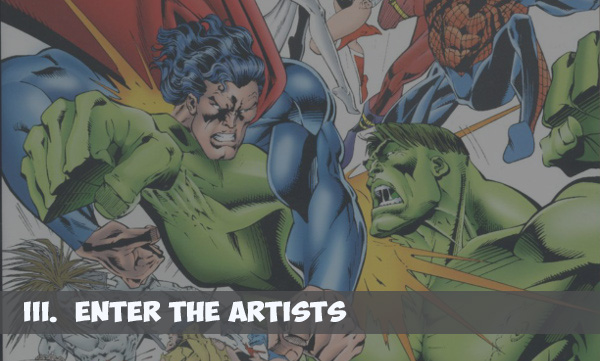
After that meeting, most everything was set. Now for the hard part: actually making it. To do that, they needed artists.
Ron Marz: The first iteration of this would have been John Romita, Jr. and José Luis Garcia-Lopez drawing the books. I was told Jose passed because he didn’t want to draw a big superhero thing.
José Luis Garcia-Lopez (Doctor Strangefate artist): I was offered just one of the stories (Editor’s Note: Doctor Strangefate) by Mike Carlin and I didn’t even (think) to turn it down. It was an interesting project with an editor I liked (still do).
Ron Marz: Then I believe Marvel offered it to Adam and Andy Kubert – this is the story I heard – and they both passed because frankly all of those guys were drawing X-Books and those books were evergreen sellers and Marvel understandably was not keen to move them off their monthly breadwinners. So the next logical choice for DC was to have Dan (Jurgens) do it, because he was – and still very much is – emblematic of what a DC book liked like at that time.
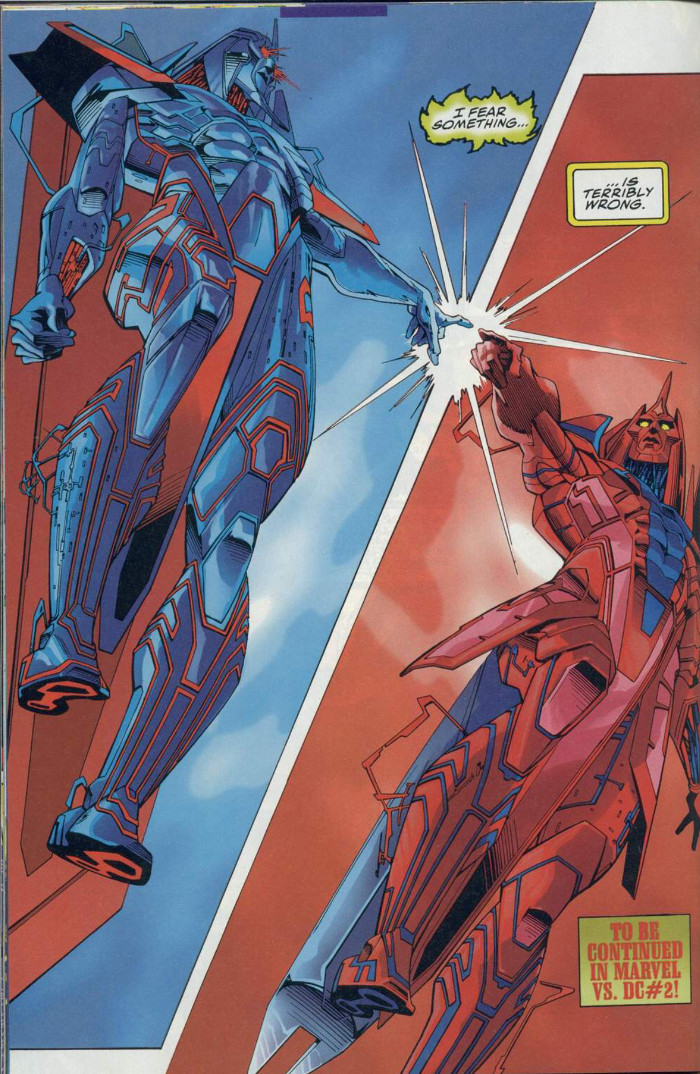
Dan Jurgens (DC vs. Marvel co-artist): Mike gave me a call one day and said, “guess what, Marvel and DC have seen the market decline somewhat in the past couple of years and we want to give it a shot in the arm and we’re going to be doing a Marvel vs. DC crossover.” He kind of set it up by explaining “we’re going to get two DC guys to do it and we’re going to get a couple Marvel guys to do it, and are you onboard?” And normally when someone offers me a project, I say, “well, give me a day to think about it.” That took all of about one millisecond to say, “oh yeah, I’m in.”
Ron Marz: Claudio (Castellini) wound up on it, I think to great extent on the strength of the Silver Surfer: Dangerous Artifacts job that he and I had done. He was not on a regular book at Marvel at the time so we weren’t pulling someone away from a book. I think it was also a factor that Claudio is very much inspired by John Buscema’s art and to me, John Buscema is the other side of the coin to Kirby at Marvel. So having a Buscema kind of sensibility on the book seemed to make some sort of historical sense.
Claudio Castellini: Mark Gruenwald (brought me in), along with assistant editor Joe Andreani, with the approval of the DC executive editor Mike Carlin. At that time, Marvel readers had only seen published covers of Fantastic Four Unlimited that I did as cover artist for about a year, and Cosmic Powers Unlimited, but of course I wasn’t (as) well known in USA as in Italy. But I suppose that the editors wanted Marvel vs. DC (as) the project that would launch me as an author in the American (market), so they chose me as artist representative of Marvel. It was a great honor for me!
Dan Jurgens: I kind of had this track record of doing statement, signature type projects anyway, so all of a sudden when you’re given the keys to the castle with the chance to draw both DC’s marquee characters as well as Marvel’s, the appeal is pretty obvious. You know you’re going to be able to have a lot of fun with something like that.
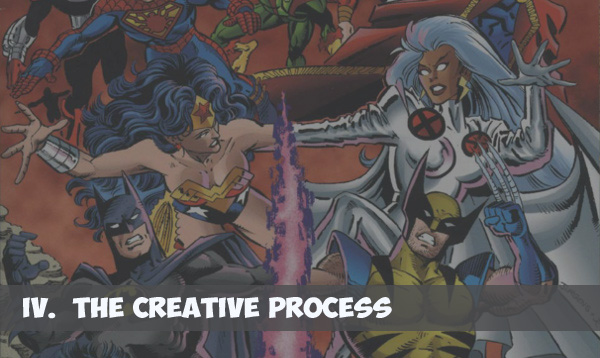
Given its unique nature that smashed two companies, two writers, two artists and a litany of other contributors together, DC vs. Marvel was always going to be a tricky project creatively. How would you make something cohesive out of all of the ideas generated in Gruenwald’s apartment? At first, it proved problematic, at least in execution.
Ron Marz: We wrote a script that was Peter and myself going back and forth every eight pages. I wrote the first eight, Peter wrote the second eight, I wrote the next eight, and he wrote the final eight of the issue. I like Peter’s work, but I also don’t think I’m telling stories out of school to say that Peter and I are very different writers. Kicking the thing back and forth every eight pages was a mess.
Peter David: We tried it with the first issue and Ron and my’s styles didn’t blend. Not on an every 8-page basis. And Mark and Mike said they didn’t like how the script of the first issue turned out.
Ron Marz: I sent (Carlin) the script, and literally about an hour later the phone rang. I picked up the phone and the first thing I heard was “what is this shit?” Which was Mike Carlin on the other end of the phone. He felt the same way I did, which was the thing didn’t hang together properly. It was not me. It was not Peter. It was somewhere in the middle that didn’t please anybody.
Peter David: So Ron and I got on the phone, and I said, “look, it’s four issues, why don’t we each just do two entire issues?” And Ron said, “if you were going to do two issues, which two would you want to do?” And I said, “I want to do issues two and four.” And Ron couldn’t believe it. He said, “I want to do issues one and three.” And I said, “well this is a compromise where everybody wins!”
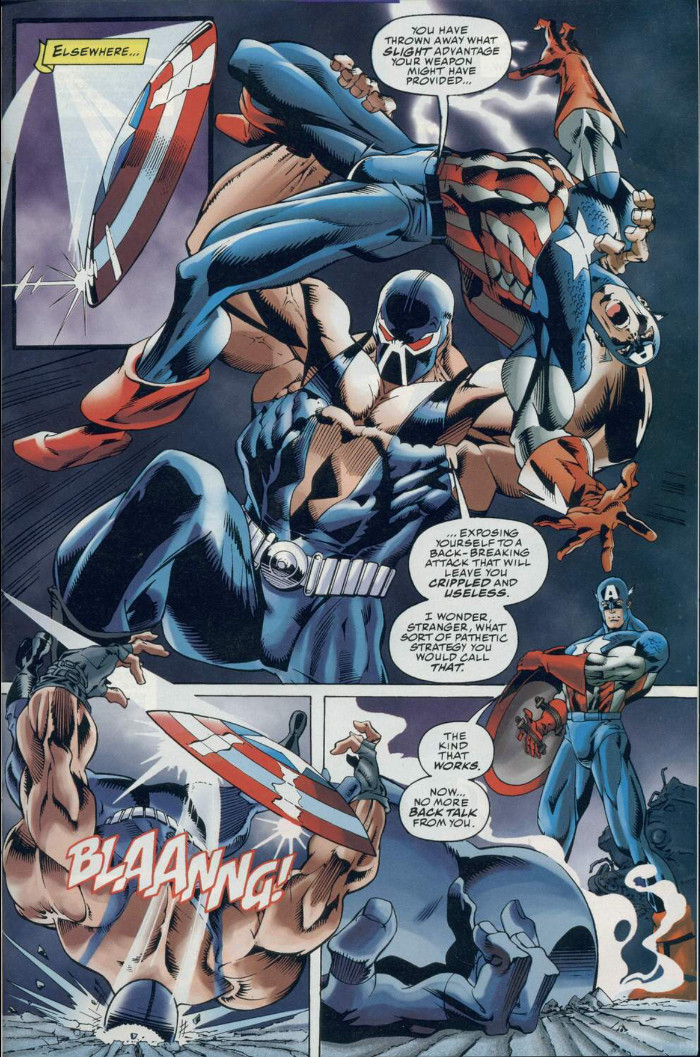
Ron Marz: I wanted to write one because it was all the set up. It was the “how does this happen?” part of it. And frankly, I had some very specific scenes I wanted to do in issue one like opening with Spider-Man coming across the Joker. And setting up Peter Parker the news photographer getting on the same paper as reporter Clark Kent and reporter Lois Lane. That stuff was fun and natural and I wanted to get it in there.
Peter David: I didn’t want to do issue one because issue one was essentially 22 or 24 pages of just setup. It was all freaking setup and introductions, because we couldn’t assume anyone who was buying issue one read both Marvel and DC. So we had to assume it was someone’s first issue. I wanted to do issue two because issue two was going to be the fights that the four of us had decided on.
Ron Marz: Issue three had all the good fights. It had all the big ones. It had the five fights that were going to be voted on by the fans, and who doesn’t want to write Batman fighting Captain America and the Hulk fighting Superman? To me, all the fights were cool. But the big deal ones were even cooler.
Peter David: Issue three I was convinced fans were going to get some stuff wrong. Like for instance, I was sure in the battle between Lobo and Wolverine, the fans were going to vote that Wolverine wins. Which is bullshit. I love Wolverine. I’m a Marvel guy. But there’s no way Wolverine beats Lobo. Lobo can take on Superman. So you know, no. Issue four was going to be the wrap up, the one that brings it together. It gets rid of the Amalgam universe and brings the whole thing together. So purely from a storytelling point of view, issues two and four were much more appealing to me.
At the center of the main book were the showdowns between the casts from DC and Marvel. There were eleven fights in total, five of which were decided by fans (for those counting at home, Marvel won six to five). The fights were the highlight of the book for all involved, even if complications did arise because of the fan voting.
Dan Jurgens: In many ways, the magic was in the battles. There’s something about just having Batman and Captain America fighting in that kind of a sequence that really, at that point, that’s kind of what you were drawing when you were 12 years old.
Peter David: Keep in mind that Ron had to double plot every fight. There were pages that were drawn that were never seen by the fans because we didn’t know how the fans were going to vote while the book was being written. So Ron had to have every fight turn out differently on the last page.
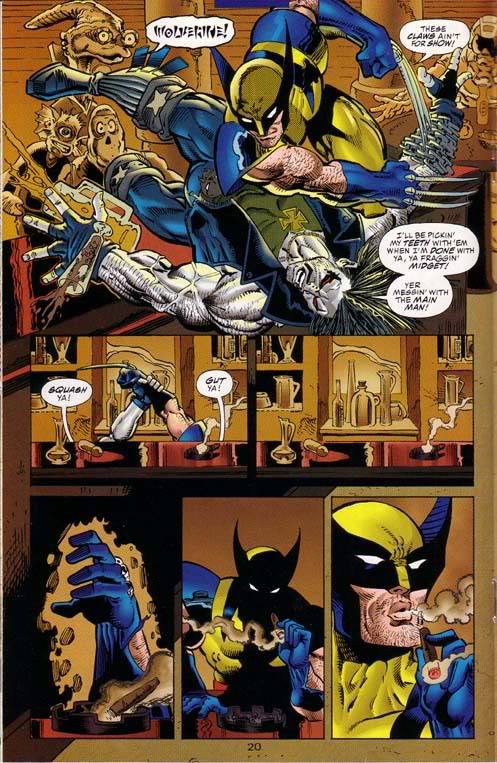
Ron Marz: The short version was I had to come up with a way to end those fights in such a way that we would be doing redundant drawing as little as possible because that obviously doesn’t help the deadline process if you’re doing stuff twice.
Peter David: In the fight where Wolverine fights Lobo, they fall behind the bar, and on the last panel Wolverine stands up. Except there’s also a page out there where Lobo stands up. Every single one had to have both interpretations. So Ron wrote at least four or five pages that never saw print.
Ron Marz: I honestly felt like the most elegant one was Wolverine and Lobo because they went behind a bar and the winner pops up and takes the cigar from behind the bar. Which obviously tells you we did it 20 years ago because you saw a character smoking.
Peter David: Ron did the best he could, but you know, even Ron couldn’t make Wolverine beat Lobo, so he had to have it all happen off panel. If you remember that one, they fall behind a bar, and then Wolverine gets up. And it’s like, no.
Dan Jurgens: That’s the only way to do it. And it’s actually kind of fun to do it that way, because even if only the 15 people that you’re working with end up seeing it, it’s like everybody gets to have their cake and eat it too at that point.
As mentioned before, this was a turbulent time at both houses. Not every character was their iconic self. That meant decisions had to be made as to which version the book reflected.
Ron Marz: That was one of the discussions early on. Were we going to reflect the current reality of the DC and Marvel universes? Or were we going to go to iconic versions of all of the characters? I was for iconic versions. Give me the traditional Spider-Man suit and give me the traditional Thor costume and give me Superman with a haircut. But ultimately the decision was that these books were basically, hopefully going to be an entrée into the Marvel and DC universes for lapsed readers and new readers, so we should reflect the current reality without getting too deep into the thickets of continuity, which is why Spider-Man’s costume wasn’t the one we preferred.
Dan Jurgens: I had an enormous packet of visual reference for the characters for the most part that were true for both Marvel and DC. This was the mid 90’s, and this is when costumes were often changing all the time (laughs), so it was a good idea to have that kind of thing going so Claudio and I could have common reference. I think that was really what they were really going for. Making sure whether it was me, him, the inkers as well, not to mention the colorists…everyone was working from the same set of visual reference.
While that could sound like the dreaded “editorial oversight,” this project was either free of that or the creative team was protected by Carlin and Gruenwald, who served as the editors on the book as well. With two major companies publishing it, the project could have been a struggle without their leadership.
Peter David: It was Mike and Mark. To the best of my knowledge it was just Mike and Mark.
Ron Marz: Peter and I had both been talked to about…“Look, these books have to go through the editors of the respective characters because that’s how this works. We want our guys to do their jobs. However, we’re going to tell them not to nitpick every last detail of how these characters are presented. If something’s really straying from the portrayal of the character that they’re comfortable with, but we’re not going to nitpick this stuff.” They were absolutely true to their word. I don’t think we had any real pushback on any of it. They let us do our jobs in the spirit of the project, which was, “look, have fun, give the fans something they can invest their excitement in.”
Dan Jurgens: A lot of times it was costume detail. Namor has a ponytail now…it was more that kind of thing. It had more to do with consistency insofar as the characters went, rather than individual stylistic notes.
Claudio Castellini: I had full creative freedom by both publishers; there was nothing more than the normal supervision of the editors.
Ron Marz: Mike and Mark were the ones with the heavy burden to bear. We got to do the fun.
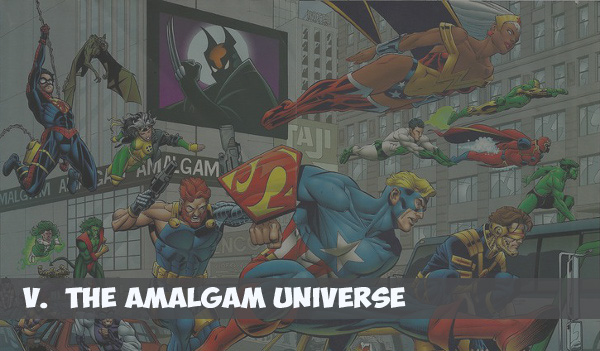
While the core book was a big deal in its own right, the separate universe that was created during the event may be the most memorable aspect of the project. In 12 comics in 1996 (and 12 more in 1997), DC and Marvel’s greatest characters became one in Amalgam Comics, a mash-up of the two universes. It was something that truly had never been seen before, outside of the sketchbooks of fans thinking what could be. It was designed as something to surprise and delight, and for many, it did just that.
Tom Brevoort: I know that the idea of Amalgam was really meant to be the big surprise part of the way through because nobody would expect it was coming. It was kind of the fun, unexpected twist in the third act that would plus up the experience beyond just being the Marvel guys and the DC guys all having a story together.
Karl Kesel (X-Patrol and Spider-Boy writer): I heard about it from Frank Pittarese (at DC) who told me to keep it on the down low. He didn’t go into detail; he just said Marvel and DC are going to do “Spider-Boy…I can’t tell you any more.” That was all of the detail he gave me, and I didn’t mention it to anyone because I really didn’t know what it meant (laughs).
Chuck Dixon (Bruce Wayne: Agent of S.H.I.E.L.D. writer): I didn’t hear about it until I was asked by editorial to participate. They had the Bruce Wayne thing picked out for me.
Jim Balent (Legends of the Dark Claw artist): I received a call from a trading card company who wanted me to illustrate this new character called Dark Claw for one of their card sets. I said, I never heard of this character, do you have reference to send me? They said no, it hasn’t been designed yet. I replied, okay, once you get reference, sure send it to me and I will draw you the card for your set. Later that week I go into the DC offices to hand in my Catwoman work and they tell me that they have this secret assignment that they want me to work on. I say sure, as long as it can be squeezed into my monthly Catwoman duties. DC says we will make it work but we can’t tell you anything about it yet.
A few weeks go by and I call the card company and asked them if they received any designs on this new character Dark Claw. They say no! So now I’m getting worried about a time crunch. Another week goes by, still no word! I’m wondering what is taking so long to design this character!
So more time passes and I go into DC again to drop off my Catwoman work and then they say, “Okay Jim, here is the secret assignment. Marvel and DC are combining Batman and Wolverine to make a character called Dark Claw and we want you to design him and draw the first issue!” I started to laugh! The editors asked me why I was laughing and I told them the whole trading card story. So in reality I have been waiting on myself to design this character for over a month!
That’s how I found out I was drawing and designing Dark Claw.
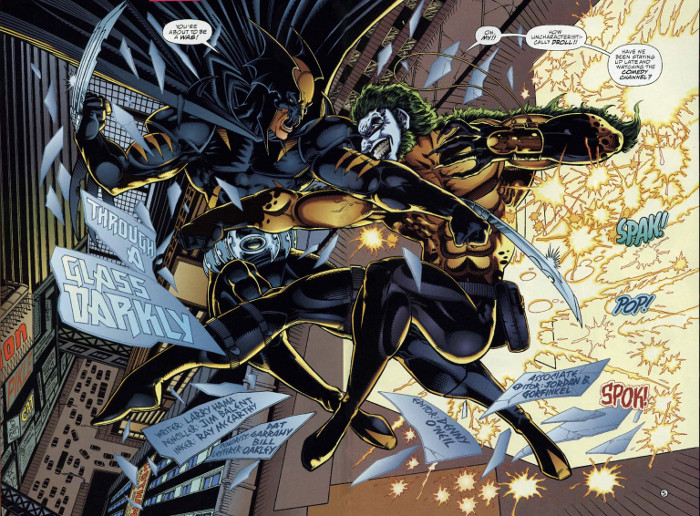
Ron Marz (Doctor Strangefate writer): Probably half the pros in comics would tell you they always wanted to do Doctor Strange because it was one of those characters that never worked sales wise but everybody wanted to do. Certainly Doctor Strange was on my list. Both Doctors had always been characters I was really drawn to, and the fact that they were going to be smushed together, I just thought I’d crawl over broken glass to work on this one.
Gary Frank (Bullets and Bracelets artist): I remember hearing that the project was coming and being pretty excited about it. I think I was on Hulk at the time, not sure, but I remember wishing I could have been involved. Then I was told that there would be peripheral books and that I’d have the opportunity to do something and I was very happy.
Ron Marz: Once I could talk about it in the office, which was not too long after, I was up at the DC offices. I was going to sit down in a meeting with Dan Thorsland – who was going to be the editor of Doctor Strangefate – so we could figure out what we were going to do and who was going to draw it and all that stuff. It was kind of a blank slate except for me at that point. And I went into Dan’s office and I said, “look, I don’t care who you get to pencil it, but you have to get Kevin Nowlan to ink it.” And he said, “okay fine, how about we get Garcia-Lopez to pencil it?” And I went, “uhh…that’d be okay!” And honestly that was kind of it. That was the extent of the meeting. And he said, “I’ll call both of them today and see if we can get everybody lined up.” They both said yes. And then I got stage fright for about two or three weeks to write the damn thing.
Kevin Nowlan (Doctor Strangefate inker): I think Dan Thorsland just called me up and asked if I wanted to ink it. The draw was José Luis Garcia-Lopez. Even if I had been reluctant to do it, it only took one look at those beautiful penciled pages to get me on board.
José Luis Garcia-Lopez: It was interesting, but besides (that), it gave me the opportunity to create a new character and recreate others I was not familiar with. First, It was demanding and that’s good because it wakes you up. Second, They were giving enough time to complete it, and third and last, Kevin Nowlan, who I admire, was going to take care of the inks. In short, these were the reasons I took the assignment.
Chuck Dixon: I love crossovers and “imaginary” tales so this seemed like the perfect combination.
Jim Balent: It reminded me of the days back in the 70’s when Marvel and DC did their crossover issues. Spider-Man meeting Superman! I loved those stories. But this was much different. The companies were combining characters to form new characters. I loved the whole idea!
Karl Kesel: I remember thinking when I heard about the Amalgam stuff that it sounded wacky. And I like wacky.
Like the main book, the Amalgam creators were given tremendous creative freedom.
Chuck Dixon: It was all left up to us. I provided a very brief plot scenario and then went to town. It was a lot of fun.
Jim Balent: The editors gave me a lot of freedom. They were great to work with.
Kevin Nowlan: It was a joy to work on and looked even better than I expected when it was finished. Matt Hollingsworth’s colors were incredible.
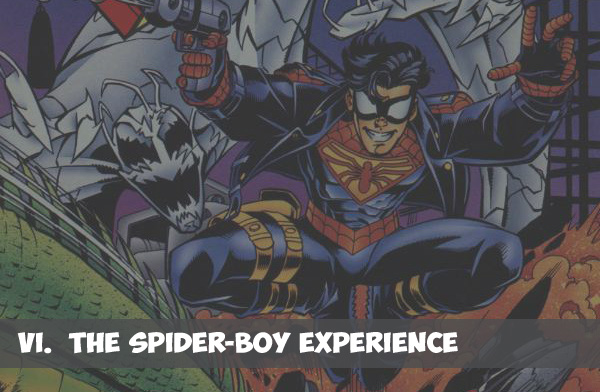
The Amalgam books were played as first issues, but also ones that belonged in a fictional, long-running universe not unlike Marvel or DC’s. The teams on each book were tasked with populating each title with as much detail as they could that played off the characters, supporting casts and worlds. Maybe no book did this better than Spider-Boy, the title written by Kesel, drawn by Mike Wieringo and edited by Brevoort. At the time, Brevoort was an editor for the Spider-Man group that often worked with oddities. Naturally, he was the one tasked with making it work.
Tom Brevoort: I do remember I hired Karl Kesel to write it.
Karl Kesel: Tom came to me first with Spider-Boy, and how can you say no to that really?

Tom Brevoort: Karl and I wanted Mike Wieringo to draw it, and Buddah (Spider-Man group Editor Bob Budiansky) wanted Humberto Ramos to draw it. I called up Bert and I forget whether it was a schedule thing or what not, but Bert wasn’t able to do it. So it ended up going to ‘Ringo, which was fine because ‘Ringo was the guy Karl and I wanted in the first place.
Karl Kesel: I never worked with Mike before. I was the one that suggested Mike for the book and I was really glad when he accepted. He was very involved in the design of the characters, like Spider-Boy and everyone else. I know we exchanged a few sketches back and forth between he and I and Tom as to what Spider-Boy would look like.
Tom Brevoort: The Amalgam books were more complicated because not only did you have me as the editor, you had Bob Budiansky as the Spider-Man group editor who had to sign off on stuff, you had Mark as the guy overseeing all of Amalgam and all of Marvel vs. DC, and you had presumably Mike Carlin on the DC side signing off on the DC stuff. You had more chefs potentially there then you would on a normal project. That being said, it was relatively easy. I really credit that to the fact that Karl was brilliant in terms of understanding the potential and the way to maximize the potential of what an Amalgam book was. What an Amalgam book really was when you get down to it is a joke. It’s not a story. What you’re doing effectively is telling a joke. You’re combining these two elements and you’re finding as many interesting wrinkles in exploring the way these two characters and their worlds combine.
Karl Kesel: It was fun because you didn’t have to worry about a huge continuity. You were making up this tapestry as you were going along. You could make references to things and characters and not really worry about the details about how they fit together perfectly. As long as they fit together at that moment was really all that mattered.
Tom Brevoort: Karl got it from the start.
Karl Kesel: I do remember specifically that I was very surprised when I handed in an outline for Spider-Boy, I got an editorial note back that I believe was from Mark Gruenwald. That I should push it farther. I should make it more outrageous. I’d never gotten an editorial note like that before! (laughs)
Tom Brevoort: I think that was probably the same kind of note that you’d have given to anybody, which was, “take this idea as far as you can…this is only going to exist for 22 pages. Wring the most out of it that you can get.”
Karl Kesel: There was no direction except names were assigned to us. It was really just a mash-up of Spider-Man and Superboy, and we were given free reign to mash together the cast and rogues gallery of those two books. And there were a certain amount of pieces not claimed by anyone, and if no one else had claimed them, you could claim them. We did that with X-Patrol when we did Doctor Doomsday. I was shocked no one had grabbed Doctor Doom at that point. Or Doomsday!
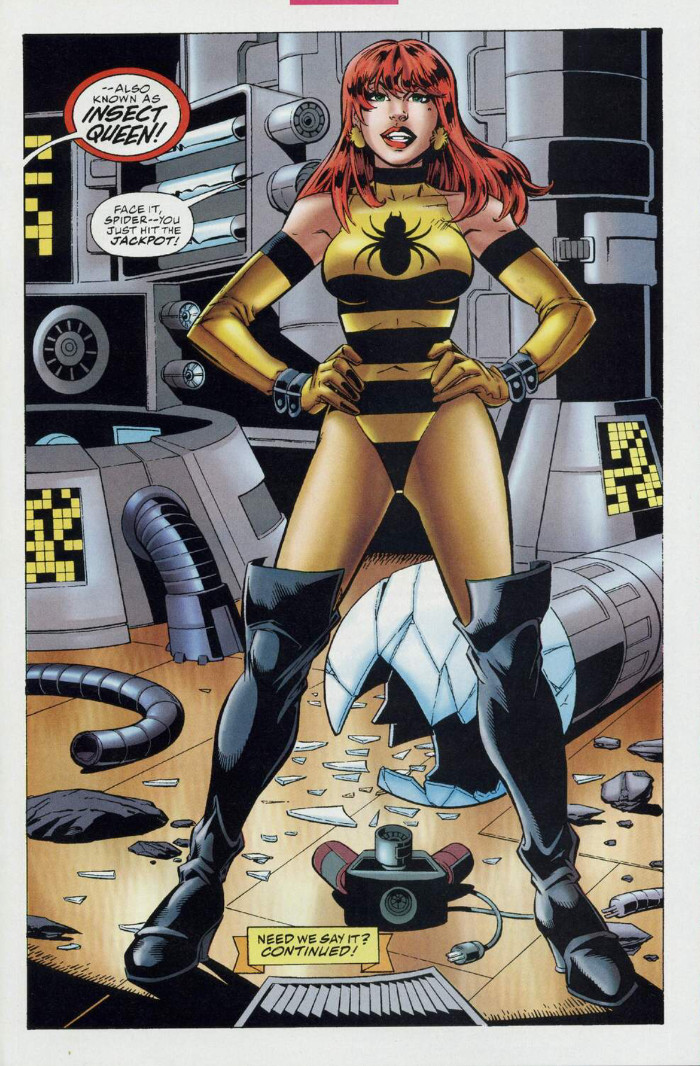
Tom Brevoort: Some of the elements and aspects he came up with for that Spider-Boy book were really incredibly brilliant. The fact the payoff at the end of the issue is Mary Jane shows up but she’s Insect Queen is a brilliant combination. It’s a Superboy gag, it’s a Spider-Man gag, it’s a Marvel/DC gag, it plays on a classic Marvel moment.
Karl Kesel: If it makes you smile, it goes in the book.
Tom Brevoort: Karl was the writer of Superboy during that period. He co-created that Superboy character, so he knew that side in and out. And consequently, he was absolutely trusted by Mike in terms of the Superboy stuff and the DC stuff being right. I’m really using Carlin’s guy. (laughs) So all anybody had to be worried about was the Marvel side, and I had that, and frankly, Karl had that too. But he just hadn’t done a lot of work at Marvel at that point.
Karl Kesel: I think more than any other project I worked on, it tapped into that fanboy side of me. I remember working on X-Patrol, which Barbara (Kesel) co-wrote with me, and we’d just fall on the floor when we figured out how in the world we could combine Starfire with Shatterstar – Shatterstarfire! (laughs)
Tom Brevoort: These were gags. These were jokes. And I don’t mean jokes in that they weren’t meant to be taken seriously. This is a particular funny thing that is being done. It is a particular game you are playing. So the more clever and more surprising and more interesting combinations you can get, the more enjoyable the reading experience was and the more fun people would have reading them.
It was all about having a good time. I guess a good enough time was had and people enjoyed it enough that we did it a year later.
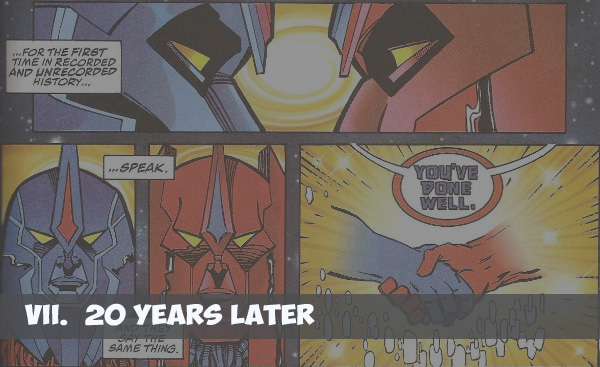
It’s been 20 years since this project was published. While it was a big deal at the time – the main book and Amalgam dominated the sales charts in a time where Marvel and DC’s reign wasn’t as clear cut – it’s more of an amusing moment in time today than a pillar in the history of comics. But it’s still something the creators themselves look back fondly on, as well as something fans remind them of.
José Luis Garcia-Lopez: The (projects) I remember most are the ones I spent months and even years to complete. But even if this was a short-lived project, I look back at it with affection. I was given the chance to create some new characters borrowing stuff from both DC and Marvel, and to make use of more shadows and lights in my drawings, something I didn’t do too much in the past. And I felt happy with the result. Yes, for these reasons, and perhaps others I can’t recall now, this was a project I can remember with a smile.
Kevin Nowlan: It’s full of good memories for me.
Jim Balent: Some (fans) even cosplay the character and come up to me at conventions! I’m always signing Dark Claw books, along with Catwoman and Batman books at cons. I even do sketches for the ones that request Dark Claw at the shows. I feel very lucky to have been given the opportunity to design and work on such an iconic character.
Karl Kesel: With some regularity, people will bring up the Spider-Boy books and X-Patrol books to sign. I think I’ve seen quite a few Spider-Boy books over the years. And people have very fond memories of it.
Ron Marz: I signed stacks of them in Mexico City when I did a convention there. I signed some copies when I did a convention in India. I think particularly for readers who were that magic age of 11 or 12 years old when the book came out; it’s a touchstone for people. I’m tickled by that. I think the stuff you discover at that age is what sticks with you the rest of your life. I think the fact that we put out a book that some people dug into at just the right age is pretty cool for me. I don’t know if I’ve ever done a signing without a Marvel vs. DC copy coming across it.
Dan Jurgens: What’s really amazing is the amount of these things that people are still bringing up for me to sign. I’m constantly amazed by that.
Peter David: I knew that I was (working on something special) because it was just new. Was I thinking of it in cosmic, historical terms? No. I thought of it as a very fun job. I think if you think of it as more than that, you’re kind of overstating yourself.
Claudio Castellini: Without a doubt I believe it was a unique and special project. It was a colossal work of pure entertainment. On a personal level it was an unforgettable and unique experience and it brings me back nostalgically to a time where the “sense of wonder” was still naively and positively present in superhero comics.
Dan Jurgens: This was the two companies working in concert to do not only DC vs. Marvel, but all the Amalgam books that spun off as a part of that as well. It was a much bigger and much more cohesive effort than anything they’d done before then.
Ron Marz: I look back at it now, and in some respects I kind of just go, “wow, did we really do that?”
Thanks to everyone for participating. The bulk of the interviews took place over phone/Skype, with several of the Amalgam interviews taking place via email. DC Comics declined on having Mike Carlin comment on the project. All titles reflective of their role then, not now.
Special thanks to the titans who helped make this event happen who are no longer with us, including Mark Gruenwald, Joe Andreani, Mike Wieringo and more.
